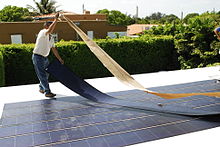David Ginger
David Ginger | |
|---|---|
| Alma mater | Indiana University Bloomington B.S. (1997) University of Cambridge Ph.D. (2001) |
| Scientific career | |
| Institutions | University of Washington Northwestern University |
| Thesis | Optoelectronic properties of CdSe nanocrystals (2001) |
| Doctoral advisor | Neil Greenham |
| Other academic advisors | Victor E. Viola, Chad Mirkin |
| Website | depts |
David S. Ginger is an American physical chemist. He is the B. Seymour Rabinovitch Endowed Professor of Chemistry at the University of Washington.[1] He is also a Washington Research Foundation distinguished scholar, and chief scientist of the University of Washington Clean Energy Institute. In 2018, he was elected to the Washington State Academy of Sciences for his work on the microscopic investigation of materials for thin-film semiconductors.[2] He was elected a member of the American Association for the Advancement of Science in 2012,[3] and was a 2016 National Finalist of the Blavatnik Awards for Young Scientists.[4]
Education[edit]
Ginger attended Indiana University Bloomington, earning B.S. degrees in chemistry and physics in 1997. During his undergraduate degree, he performed research with Prof. Victor E. Viola. Ginger pursued graduate school as a British Marshall Scholar and an NSF Graduate Fellow in Physics at the University of Cambridge, where his Ph.D. thesis advisor was Prof. Neil Greenham. Ginger earned his Ph.D. in 2001 with a thesis entitled Optoelectronic properties of CdSe nanocrystals. After a joint NIH and DuPont Postdoctoral Fellowship at Northwestern University with Prof. Chad Mirkin, he joined the faculty of the University of Washington.[5]
Research[edit]


Ginger specializes in the physical chemistry of materials with applications in energy, electronics, and sensing. His team has used combinations of optical and scanning probe microscopy to examine the properties of nanomaterials, particularly thin film semiconductors. The lab has studied mixed ionic/electronic transport materials such as those used in bioelectronics[6] batteries, and most notably in photovoltaic materials such as halide perovskites[7][8] and organic photovoltaics.[9]
References[edit]
- ^ "David S. Ginger | Department of Chemistry | University of Washington". chem.washington.edu. Retrieved 2021-06-05.
- ^ "David Ginger, Sotiris Xantheas elected to the Washington State Academy of Sciences | Department of Chemistry News". Retrieved 2019-05-27.
- ^ "AAAS Members Elected as Fellows | American Association for the Advancement of Science". www.aaas.org. Retrieved 2021-06-05.
- ^ "National Finalists | Blavatnik Awards for Young Scientists". blavatnikawards.org. Retrieved 2021-06-05.
- ^ "David S. Ginger". The Ginger Lab - University of Washington, Seattle – David S. Ginger. July 27, 2016.
- ^ Giridharagopal, R.; Flagg, L. Q.; Harrison, J. S.; Ziffer, M. E.; Onorato, J.; Luscombe, C. K.; Ginger, D. S. (July 2017). "Electrochemical strain microscopy probes morphology-induced variations in ion uptake and performance in organic electrochemical transistors". Nature Materials. 16 (7): 737–742. Bibcode:2017NatMa..16..737G. doi:10.1038/nmat4918. ISSN 1476-4660. PMID 28628123.
- ^ de Quilettes, D. W.; Vorpahl, S. M.; Stranks, S. D.; Nagaoka, H.; Eperon, G. E.; Ziffer, M. E.; Snaith, H. J.; Ginger, D. S. (2015-05-08). "Impact of microstructure on local carrier lifetime in perovskite solar cells". Science. 348 (6235): 683–686. Bibcode:2015Sci...348..683D. doi:10.1126/science.aaa5333. ISSN 0036-8075. PMID 25931446.
- ^ deQuilettes, Dane W.; Frohna, Kyle; Emin, David; Kirchartz, Thomas; Bulovic, Vladimir; Ginger, David S.; Stranks, Samuel D. (2019-10-23). "Charge-Carrier Recombination in Halide Perovskites". Chemical Reviews. 119 (20): 11007–11019. doi:10.1021/acs.chemrev.9b00169. ISSN 0009-2665. PMID 31496228. S2CID 201982762.
- ^ Pingree, Liam S. C.; Reid, Obadiah G.; Ginger, David S. (2009). "Electrical Scanning Probe Microscopy on Active Organic Electronic Devices". Advanced Materials. 21 (1): 19–28. Bibcode:2009AdM....21...19P. doi:10.1002/adma.200801466. ISSN 1521-4095. S2CID 138146880.
External links[edit]
- Living people
- 1974 births
- People from Centerville, Ohio
- Indiana University Bloomington alumni
- Alumni of the University of Cambridge
- Marshall Scholars
- University of Washington faculty
- American physical chemists
- 21st-century American chemists
- Recipients of the Presidential Early Career Award for Scientists and Engineers
